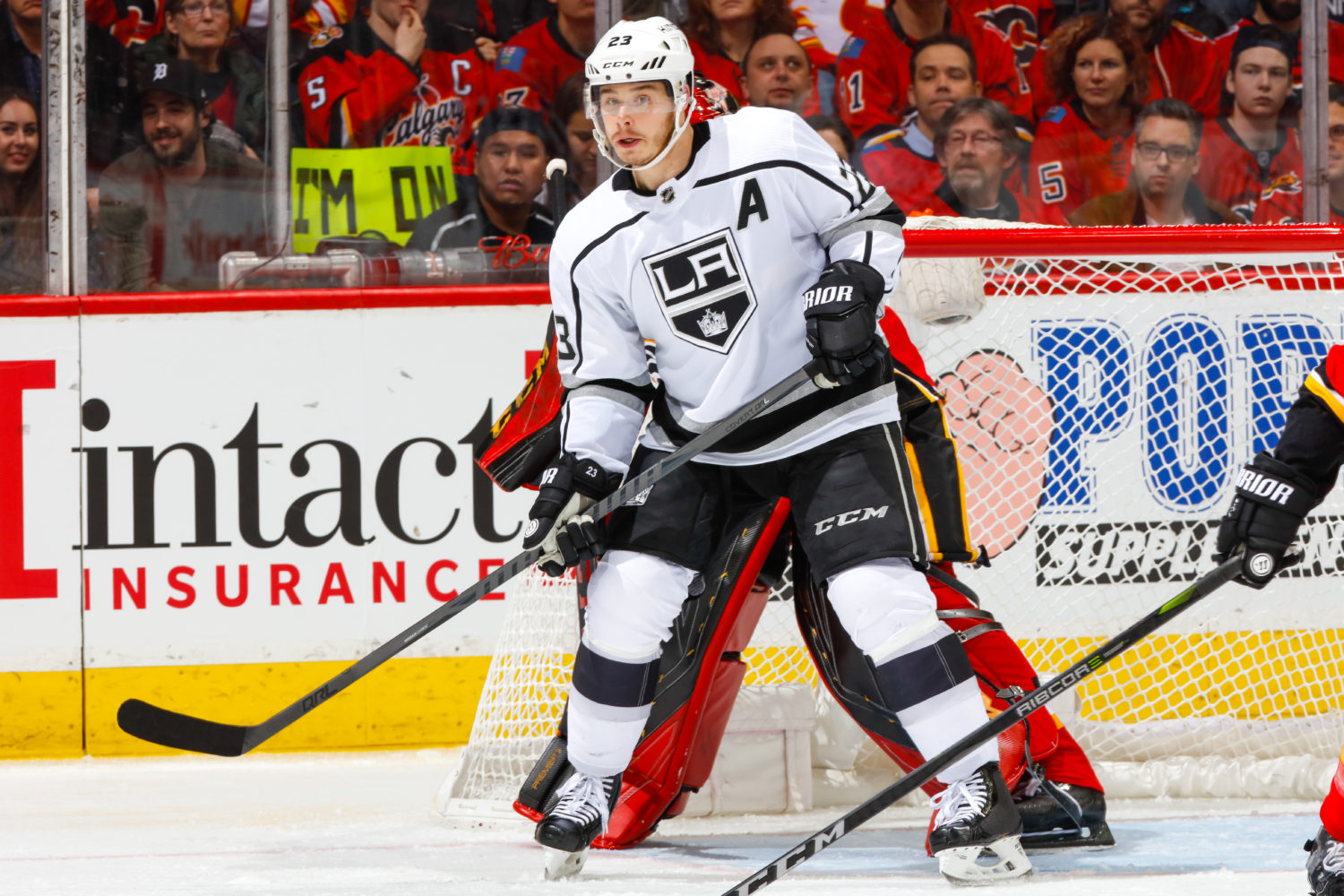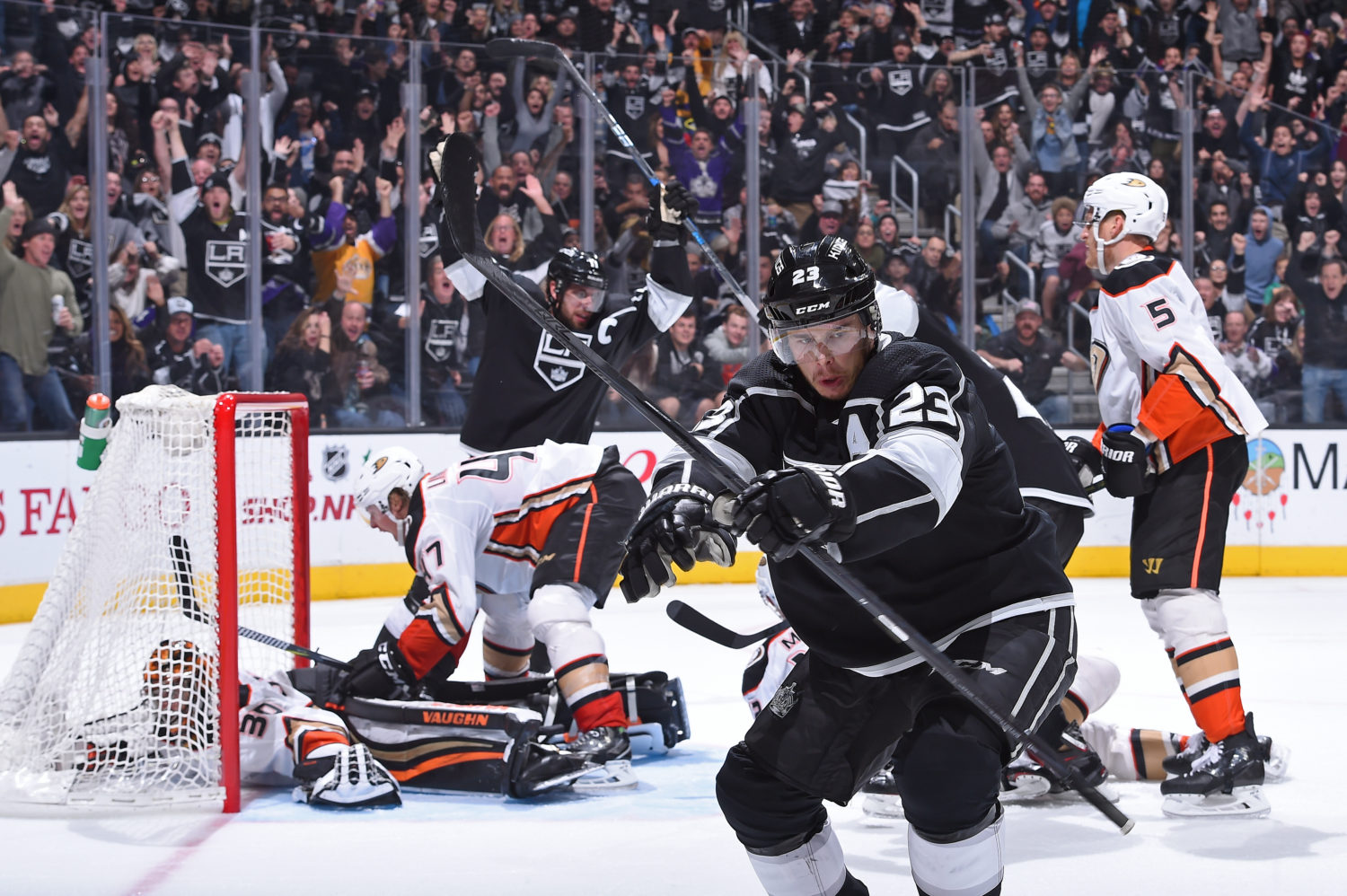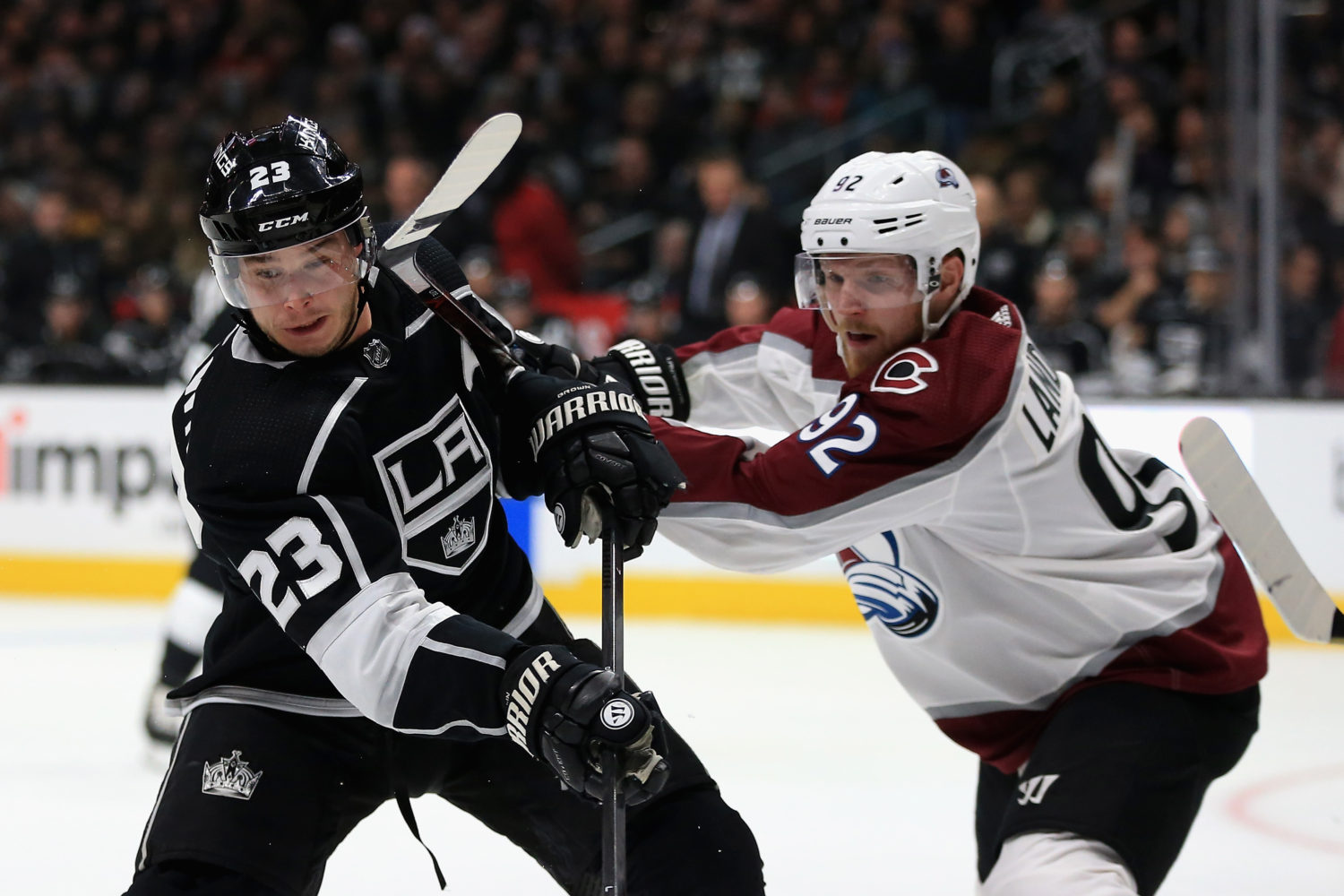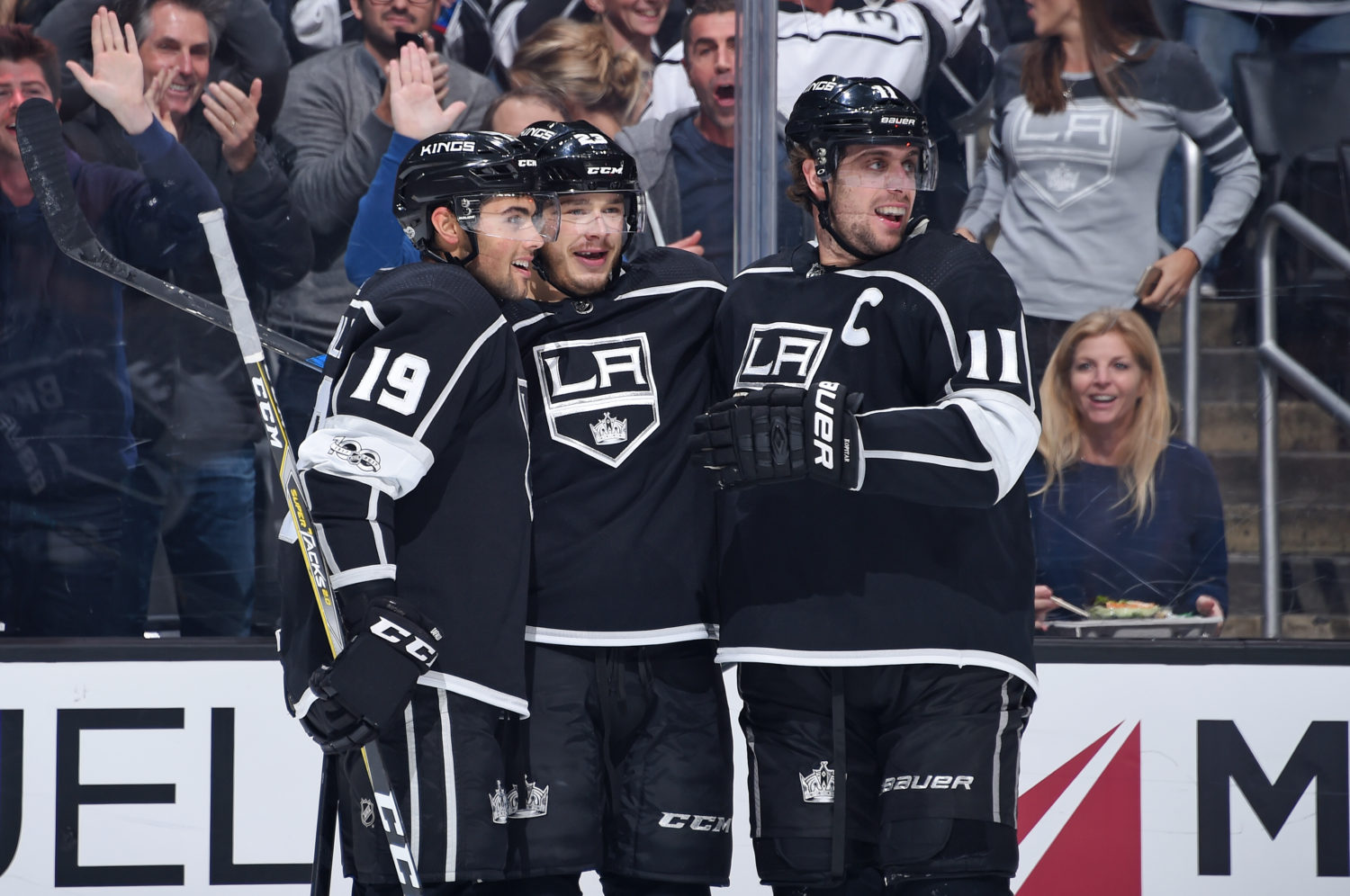This season: 81 games, 28 goals, 33 assists, 61 points, 58 penalty minutes, +31 rating, +4.0 CF%Rel, 1.034 PDO, 19:50 time on ice
The good: As John Stevens met individually with every King in preparation for his first season as head coach, he knew there were layers of production to be unearthed within Dustin Brown. He spoke – again and again, to the many people who asked – about how he saw good trends in Brown’s game in 2016-17 and wanted him to get back to being the hard, all-purpose “big man with good hands” who can help the team in a variety of situations, and, importantly, put the puck in the net. “After watching and reviewing our team and situations on our team and what he was doing and things he did around the net, I told him [last] summer, ‘I don’t see any reason why you can’t go back to being a 20 goal scorer,’” he said early in the season. Taking full advantage of a nearly four-minute spike in usage from the season prior, Brown flirted with 30 goals while setting career-highs in assists and points. Say what you will about plus-minus, but when you’re a +31, and a +4.0 CF%Rel, and regularly seeing the ice alongside Anze Kopitar against the other Anze Kopitar-like players, you’re grading above and beyond any curve. According to Corsica’s algorithm, which analyzes offensive, defensive, special teams and even strength data, he’s currently the 14th-ranked NHL right wing and is slotted ahead of players like Phil Kessel and Jakub Voracek. This, of course, is juxtaposed with the context in which Brown, you know, recorded 27, 27 and 28 points before rising to 36 last season. Brown’s resurgence was influenced by a number of factors, among them his quietly solid season one year prior, the commitment to use him in all situations, the chemistry he generated with Anze Kopitar and Alex Iafallo, and his tried and true ability to crash the net, take the eyes away from goaltenders, and create havoc and chaos near the goal. Brown took advantage of the extra slack afforded him and took great advantage of the additional situational usage, which seemed to ignite his overall game, confidence and drive.
Also, he was having fun! Fun, fun, fun, fresh start, fun. Whoa, was this a Kings season, or a Kevin James movie?! At the center of the chorus was the rejuvenated Brown, who no longer was bringing home the weight of the last several seasons, nor the burdens of a complicated relationship with Darryl Sutter, if we’re to be a touch diplomatic. He, like his accomplished teammates, was ready to “prove a lot of people wrong,” and the 11-2-2 record out of the starting gates was constructed in part by the constitution of a bunch of players who weren’t happy with where their games had fallen. “I remember losing the overtime game in Anaheim [at the end of 2016-17], and things were said after the game, and I think guys went home with a different attitude,” he said. “Come back ready to at least make the next step, which was the playoffs – but obviously it didn’t go how we wanted this year.”
Before the playoffs, Brown appeared in his 1,000th game, a testament to his durability and ability to play through pain. He’s missed only five of the team’s last 704 games due to illness or injury, and was presented with his silver stick one week after Marian Gaborik even though Gaborik had made his NHL debut three years earlier. He scored the overtime winner in his 1,000th game, scored four times against Minnesota, cited Brian Boyle’s plight when nominated for the Masterton Trophy and received two fourth place votes for the Selke. Few players dedicate themselves so encompassingly to their game, and Brown’s off-season approach – one disrupted this summer – is like Jeff Carter’s, a model for younger players to follow. He still meets regularly with Bill Ranford during the regular season to go over net-front tactics and goaltending tendencies and is among the league’s most effective net screeners and quick-hands playmakers from close range. His offensive zone spacing, on display with Kopitar, and Iafallo, was phenomenal, with Kopitar also benefiting from the rookie’s subtle touches and offensive zone puck pursuit. Interestingly, although he posted quality but not earth-shattering possession and scoring chance rates alongside Iafallo and Kopitar, the trio’s goals-for percentages were exceptionally (and disproportionately) good, sustained by inflated PDOs and high shooting percentages well above the team’s overall rate. That’s not any sort of breaking news; this was a first line – a very good first line – that carried the team as the secondary scoring ebbed and flowed. “Brownie’s earned the right to play with a great player in Kopitar. He’s earned the right to kill penalties and play on the power play in that situation, and he’s a big minute player for us because of his performance,” Stevens said. “He’s a guy that’s won two Cups here, and he was a big part of those Cups. He knows how to win. He’s honest with his game. I think he got off-track there for a little bit, but he was honest with what kind of player he needed to be, and he was willing to do the work to become that player again. I know a lot of people are surprised, and it’s easy to say this now that he’s had success, but I’m not surprised. I really thought Brownie is a good player still in the league and he’s continue to be a good player, and I really felt he’s an important guy on our team, and I’ll stand by that.” Brown took 36 shots on the power play and led the club with nine goals. His three overtime goals led the team, while his six game-winners were tied for the team lead.
The bad: The “bad?” For Dustin Brown? In 2017-18? “Yes,” you say, “for Dustin Brown.” “Really?” I answer. “THOSE GAMES IN 2014 TOOK TOO LONG,” you reply. “I TIRE OF DOUBLE OVERTIMES. NOTHING PLEASES ME.” Brown ran afoul of league justice and was fined and suspended on separate occasions in 2017-18, which means his past history may come into consideration as a “repeat offender” should he find himself this season on the wrong side of the blurry line he’s negotiated quite well for the large majority of his career. He generated his own share of scoring chances in the playoffs, but as much as his resurgence was built upon his bread-and-butter net-front game, it was a shame he wasn’t able to bury this in Game 1. Against any goalie other than 2018 Playoff Marc-Andre Fleury, Brown probably scores two or three goals in those four games.
Going forward: Brown underwent shoulder surgery in late April and is expected to be ready for training camp. “You don’t like to see a guy in a rehab situation. You want him to be training. But we feel like he can be fully rehabbed, fully trained, ready to go,” Stevens said in early July. (Brown missed two games while dealing with a shoulder injury midway through the 2016-17 season, for what it’s worth.) The highs reached in 2017-18 will not be easy for Brown to match, but any failures to replicate his recent renaissance will be cushioned by an overall rising tide of team offense and should be partially off-set by a more fruitful Pearson-Carter-Toffoli connection and the growth of several additional secondary pieces.
Brown wore an “A” on his jersey in Jeff Carter’s absence, and even though he’s no longer captain, he’s among the revered presences in a Kings room that will continue to add youth and depth to its aging but effective core. He knows the room so well and the right times to speak up and, with the media, when to share cogent, pithy observations of the state of the game and where the team is at. Entrenched in the team’s leadership core, and sustained by an approach that allows him to play 80 to 82 games year in and year out, he’s the representation of the club’s culture and the heartbeat emanating throughout the room. “If you could rewrite history and we don’t win in 2012, maybe even Kopi’s not here right now. Maybe I’m not here. Maybe Quick,” Brown said before his 1,000th game. “Everything changes, because success breeds success. I think we’ve had a lot of players set a lot of organizational milestones, records, and it’s a result of a collective group of players that has been really good for a decade now. It’s been less individual than it might seem. 1,000 games for me is a result of playing with really good players for the last 600.” Brown is signed through 2022 at $5.875-million per season and will provide – gasp! – pretty good value in the immediate future if he doesn’t fall far from his career heights.
Brown evaluations: 2017 | 2016 | 2015 | 2014 | 2013 | 2012 | 2011 | 2010 | 2009 | 2008
Player evaluations: #3 DION PHANEUF | #6 JAKE MUZZIN | #7 OSCAR FANTENBERG | #8 DREW DOUGHTY | #9 ADRIAN KEMPE | #11 ANZE KOPITAR | #13 KYLE CLIFFORD | #19 ALEX IAFALLO | #22 TREVOR LEWIS | #23 DUSTIN BROWN | #24 DEREK FORBORT | #27 ALEC MARTINEZ | #32 JONATHAN QUICK | #44 NATE THOMPSON | #52 MICHAEL AMADIO | #70 TANNER PEARSON | #73 TYLER TOFFOLI | #77 JEFF CARTER | KUEMPER / CAMPBELL | THE OTHERS
-Lead photo via Gerry Thomas/NHLI
-Advanced stats via Natural Stat Trick, Corsica






Rules for Blog Commenting
Repeated violations of the blog rules will result in site bans, commensurate with the nature and number of offenses.
Please flag any comments that violate the site rules for moderation. For immediate problems regarding problematic posts, please email zdooley@lakings.com.